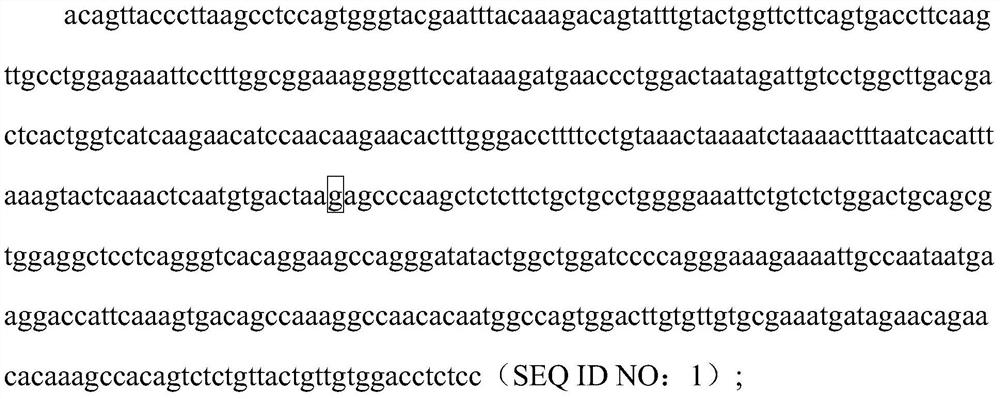SNP site related to stress resistance of lateolabrax japonicus and application of SNP site
A stress-resistant and site-based technology, applied in recombinant DNA technology, microbial determination/inspection, DNA/RNA fragments, etc., can solve problems such as germplasm degradation, lack of excellent species of perch, destruction of wild perch resources, etc. To achieve the effect of good immune performance
- Summary
- Abstract
- Description
- Claims
- Application Information
AI Technical Summary
Problems solved by technology
Method used
Image
Examples
Embodiment 1
[0018] Example 1: Screening SNP sites
[0019] 1. Extraction of total RNA from sea bass:
[0020] Total RNA was extracted from the liver of sea bass according to the Trizol method.
[0021] 1) Tissue: Take 5mg of liver tissue and place it in a 1.5ml centrifuge tube, add 1ml Trizol to fully homogenate, and let stand at room temperature for 5 minutes;
[0022] 2) Add 0.2ml chloroform, shake for 15s, let stand for 2min; then centrifuge at 4°C, 12000g×15min, take the supernatant;
[0023] 3) Add 0.5ml of isopropanol to the supernatant, mix the liquid in the tube gently, and let it stand at room temperature for 10 minutes; then centrifuge at 4°C, 12000g×10min, and discard the supernatant.
[0024] 4) Add 1 ml of 75% ethanol to the precipitate, and gently wash the precipitate. 4°C, 7500g×5min, discard the supernatant, add appropriate amount of DEPC H after drying 2 O dissolved.
[0025] 2. Synthesize cDNA:
[0026] Using 2μg total RNA as a template, add 1μl 20μM Oligo d(T) 18...
Embodiment 2
[0045] Example 2: Homozygous individuals with genotype 264CC carry out infection experiments
[0046] Selected genotype 264CC Chinese perch individuals were selected for the injection infection experiment of Edwardsiella tarda, and the intraperitoneal injection concentration of each tail was 4.0×10 6 50 μL of CFU / mL bacterial solution; regularly observe and record the number of dead fish in each experimental group every day, and calculate the mortality rate of individuals with different genotypes.
[0047] The results showed that individuals with genotype 264GG had a higher incidence in injected infected individuals than individuals with the other two genotypes (Table 2).
[0048] Table 2: Injection infection incidence of three genotypes of Chinese perch
[0049] genotype number of cases Morbidity Fatalities lethal dose rate CC 2 / 18 11% 0 0% CG 9 / 30 30% 3 10% GG 23 / 30 77% 19 63%
[0050] Note: Indicates survival, number of deat...
PUM
 Login to View More
Login to View More Abstract
Description
Claims
Application Information
 Login to View More
Login to View More - R&D
- Intellectual Property
- Life Sciences
- Materials
- Tech Scout
- Unparalleled Data Quality
- Higher Quality Content
- 60% Fewer Hallucinations
Browse by: Latest US Patents, China's latest patents, Technical Efficacy Thesaurus, Application Domain, Technology Topic, Popular Technical Reports.
© 2025 PatSnap. All rights reserved.Legal|Privacy policy|Modern Slavery Act Transparency Statement|Sitemap|About US| Contact US: help@patsnap.com



